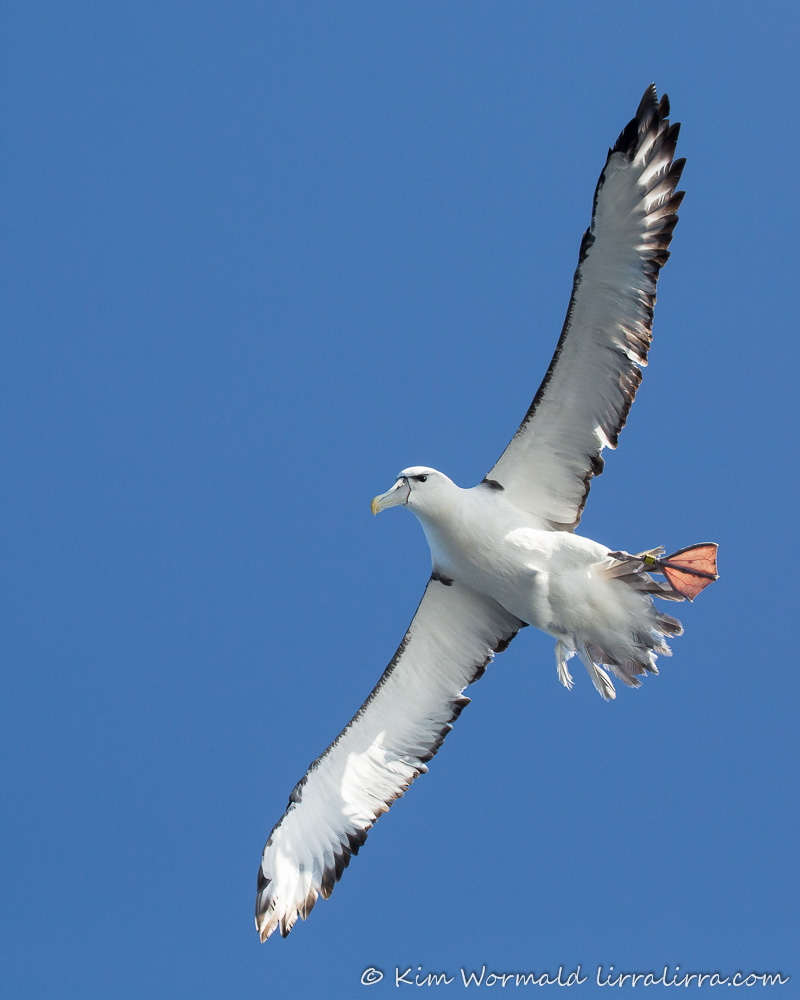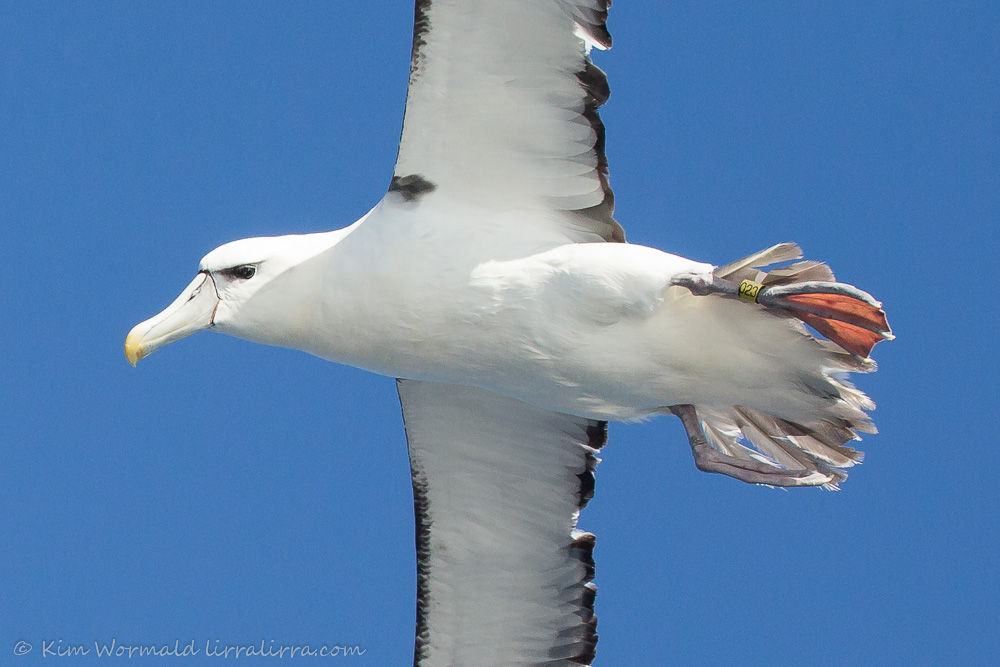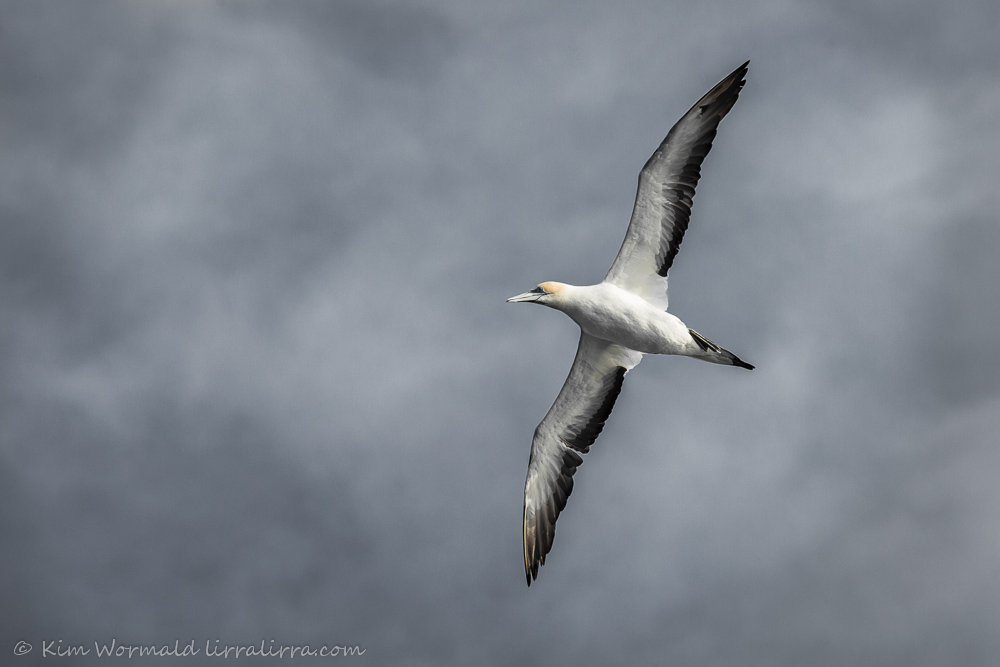The Shy Albatross that featured in Pelagic Pain and Pleasure (and again below) has a scientific band on its left leg. Over the past couple of weeks I’ve done some research and thanks to David from the Australian Bird and Bat Banding Scheme in Canberra, and Rachael from the Threatened Species and Marine Section of the DPI in Tasmania I have some fascinating news to share.
 Shy Albatross (Thalassarche cauta) – aka left leg yellow 023
Shy Albatross (Thalassarche cauta) – aka left leg yellow 023
David put me onto Rachel who needed the band number to find out whether the Shy Albatross above had been banded as a chick or an adult. She could tell by the yellow darvic band that it was a bird from Albatross Island and that it had once sported a satellite transmitter. I sent her a close up of an image (below) where the number 023 can clearly be seen. Rachael was thrilled to know it had survived since being banded (by Dr RP Gales) as a nestling, and tracked as part of “The Big Bird Race” in April 2004.
Ten years and ten days had passed since the Shy Albatross was banded and I took my perilous trip to open waters and photographed it. It’s unknown whether it is male or female but they do know that it was 311 km from the banding site when the image above was taken. The albatross was one of only six that was tracked for 60+ days at sea.
Rachael kindly sent me a paper she co-authored, titled Post-fledging survival and dispersal of shy albatross from three breeding colonies in Tasmania by R Alderman, R Gales, AJ Hobday & SG Candy (2010) where it states that albatross are the most threatened bird taxa with many populations in decline, predominantly because of the loss of birds due to commercial fishing; juveniles are particularly vulnerable.
According to the paper, Shy Albatross breed exclusively on three offshore islands around Tasmania. Nestlings were fitted with transmitters in 2004; not all of the birds left the islands but the remains of only one chick were recovered on Albatross Island. Of the 48 birds that were fitted with satellite transmitters on Albatross Island, Mewstone and Pedra Branca a staggering “23 (49%) [were] assumed to have died upon or soon after fledging”. Twenty-five of the birds were tracked for between 10 and 80 days at sea; 10 were from Albatross Island; they travelled at an average speed of 18km per hour. Seven bands from Mewstone chicks were recovered in South African waters while Albatross Island juveniles tended to head for areas around Kangaroo Island and the Eyre Peninsula.
It is remarkable that ‘our’ bird had not been sighted since being banded. Shy Albatross return to the place they hatched when they themselves are ready to breed, this doesn’t happen until they are at least 7 or 8 years of age. Rachael commented that she hopes to see Yellow 023 at the Albatross Island colony in upcoming breeding seasons. I’ll keep in touch with her and will let you know if it turns up, hopefully when it turns up!
There were several species of Shearwater seen on the pelagic trip, if anyone can help ID the bird above I’d be grateful.
As we headed back to Portland the seas were calmer and I was pleased to be feeling well enough to look at the gannets on and around Lawrence Rocks, 2km south of Portland. None of them came particularly close but it felt good to have my camera in my hands again and I was happy to capture the gannet above as it flew gracefully past the boat.
Happy birding, Kim
Important request from David at ABBBS:
If you find a bird with a band, wing tag, or some other markings, the ABBBS would like to hear about it (abbbs@environment.gov.au or 02 6274 2407) with the following information:
- the band number, where and when you found it, what you think happened to the bird, where the bird and band are now, notes about any other marks on the bird.
If the bird is not alive, the ABBBS would like you, if possible, to:
- remove the band, gently straighten it, stick it to cardboard, write the band number onto the cardboard, mention if you telephoned the ABBBS about the band, send the band to ABBBS at GPO Box 8, Canberra, ACT 2601.
The ABBBS will be very glad to hear from you and will send you a letter telling you where and when the bird was banded.
NB It is possible to receive a weekly email informing you that lirralirra has been updated – just add your address to the ‘Subscribe to email’ box above right.
Also, I have added a Facebook button – thank you ‘likers’, clicking the button is appreciated – sometimes ‘likes’ show up on the home page and sometimes on the post itself.




[…] The ABBBS band on this Shy Albatross was readable – which was exciting for me and even more exciting for the team who had banded it ten years previously. I wrote about this fascinating bird in an earlier post: Missing in Action for Ten Years […]
Almost a year later- but I think your mystery bird is a Sooty Shearwater also known as a Mutton Bird in New Zealand. We once had an injured one blown into our yard on the Otago Peninsular on a weird windy summer stormy eve- my Dad came inside saying he thought it was a baby albatross. 🙂 We took her to some bird people we knew through Otago Museum and they said she was a Sooty.. she was released again when he was healed up.
Your website has been a godsend for me today as I’ve tried to accurately identify some birds we’ve seen for a personalised field guide notebook for my boys to use here in Perth. Their latest favourite made-up game is called ‘Nature Trackers’ – which essentially amounts to bird spotting with Toilet roll binoculars. 🙂 Not having local bird knowledge is so frustrating. Thank-you so much for providing such a wonderful resource!
Hi Gypsy, a Sooty Shearwater would be great! We call Short-tailed Shearwaters ‘Mutton Birds’. It’s great that your Sooty was fine to go after a rest.
I’m rapt that lirralirra has been helpful and love the idea of your boys going birding with their dunnyroll-bins – what lucky boys!
Happy birding, Kim 🙂
How absolutely wonderful. Long may it survive.
Thank you – lovely to read such a positive post this morning.
I’m glad you thought so EC, me too!
Fascinating to learn about the banding information and tracking service. Really hoping that Yellow023 makes it back to breed. Amazed that they need to survive 7 long years until breeding begins. Is that an unusually long period in bird life?
Kinda makes that horrible trip worthwhile Kim?
Great pic of you Lyn! I hope 023 manages to breed too. 7 years is the earliest they might breed and it’s not unusual with seabirds. My post about the PI shearwaters a while ago mentions that they don’t start breeding until they’re at least 5, which is 5 long trips to the other side of the world. I think I added up the km’s they travel before even producing their first egg, it’s phenomenal.
I’m really pleased to have let David and Rachael know 023 is still going strong, I’m trying to write that it makes the horrible trip worthwhile but my fingers won’t let me type it!
Hi Kim,
My husband, Angus believes it is a Skua not a Shearwater in your pic.
Thanks again for interesting blog and marvellous photos.
Alison
Ah it could be! I still feel queasy when looking at the pelagic images and can’t manage to open a field guide yet, or even look at the list of species sent by the organisers of the trip. Thanks to you and Angus for letting me know, and I’m so pleased you enjoy lirralirra 🙂
PS Alison, does Angus know what kind of Skua or does the image miss the important bits?
Great post! Thanks for the exciting info! Love the photos of the Albatross and the
Gannet! Have a great weekend!
I’m glad you like the post Eileen, a good weekend to you too!
I didn’t know that about the bands. Thanks for the info!
You are very welcome! It was great to learn more about the albatross myself; I feel lucky to have seen it, especially on such a difficult trip.
Kim, that is so special. What adventures that beautiful bird could tell of the last ten years. Your head must be spinning between birds and puppies.
It would be interesting if the transmitter had transmitted the entire time. You’re right about puppies, they’ve overtaken my thoughts this week – I seriously considered postiing puppy images here this week!